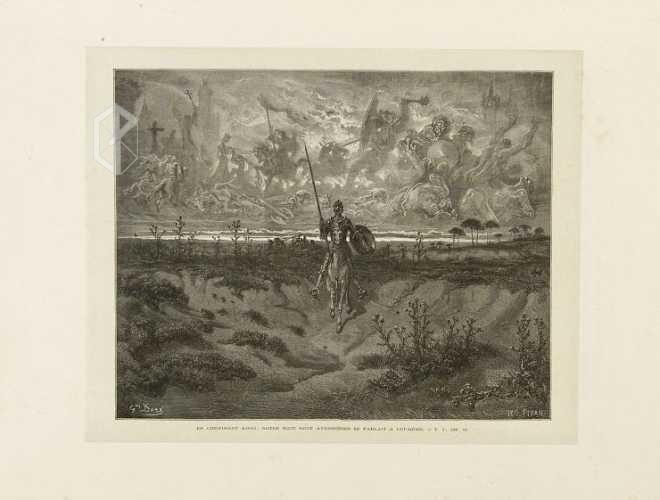
Drawing and engraving are execellent.
 |
|
| Image | 1863Paris-Hachette-01-005 |
| Illustration No. | 1 |
| Illustrator | Paul Gustave Louis Christophe Doré |
| Engraver | Héliodore Joseph Pisan |
| Lithographer | |
| Title Caption | EN CHEMINANT AINSI, NOTRE TOUT NEUF AVENTURIER SE PARLAIT A LUI-MÊME. |
| Title Supplied | |
| Part | Part I, Madrid 1605 |
| Chapter | Chapter 2 |
| Subject |
2.1 First sally |
| Illustration Type |
Chapter illustration |
| Technique |
Wood engraving or Xylography |
| Color | Black and white |
| Volume | I |
| Page Number | f.p. 14 |
| Image Dimension | 197 x 247 |
| Page Dimension | 433 x 313 |
| Commentary | Excellent representation of don Quixote and Rocinante on his first sally; Doré combines with great mastery the reality (don Quixote riding Rocinante through the dry and austere landscape of La Mancha) and fantasy (adventures, knights, giants... imagined by don Quixote as shadows or ghosts in the sky).
Drawing and engraving are execellent. |
| Notes | "Todas las tendencias del arte romántico, tal como hemos ido viéndolas surgir, unas tras otras, están aquí condensadas: primero, la desbordante fantasía. Sirva de muestra la salida inicial de Don Quijote. [...] Y ahí están, en efecto, representadas por la fantasía del artista, sobre el rosicler del alba, esas luchas quiméricas y gigantescas. Contrastando con ellas, debajo de ellas, yace la áspera o banal realidad: la tierra seca, sólo sembrada de cardos y algunos pinos dispersos; el polvoriento camino desierto, y el pobre labrador, diminuta silueta en el fondo del cuadro, afanándose por ganar con el sudor de su frente, apenas despunta el día, el duro pan cotidiano. Esta admirable estampa viene a recordar, con relación al Quijote, lo que vemos en el Entierro del Conde de Orgaz, pintado por el Greco: triste realidad abajo, esperanzadora fantasmagoría arriba" (GG228). |